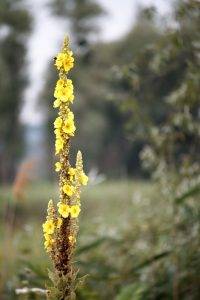
Gourdwort – Verbascum thapsiforme
Description of the thapsulphur:
Verbascum thapsiforme Old or other familiar names: ox-tailwort, ox-tail flower, mullein, woolly-grass Common name: knapweed The oxtailwort is a biennial plant. In the first year, when it emerges from seed, it does not yet produce flowers, but only thick, strongly woolly leaves with an ovate shape, with a lobed edge and a pointed tip. In the second year it shoots up, flowers, sets seed and then withers. The stems grow straight upwards, standing like a candle (hence the name ‘candela regium‘, or king’s candle). The stems do not branch much; they can reach a height of two metres.  Its leaves are scattered on the thick stem; the lower ones are tongued, the upper ones are tongue-less, egg- or inverted-egg-shaped, with lacy edges and pointed tips. The leaf plate extends beyond the base of the leaf to the stem, i.e. it runs down and dries on both sides of the stem to the next leaf below. Such a stem is called a panicle. Stem and leaf covered with a dense yellowish-grey fur. The flowers are borne on the top of the stem by tiny elongated blackberry leaves and form a cluster of flowers 0.5 m long. The flowers are very short-stalked, densely arranged above each other. Outside the flower parts is the greenish, five-lobed calyx; inside this is the canary yellow panicle, which forms a very short tube at the bottom and a widening, rounded upper part with five lobes, but the lobes are not quite equal. Of these, the upper three are shorter and conspicuously bearded with long white wool, while the lower two are much longer and bald. In the centre of the flower is the seed coat, from which the ovary is produced, the latter containing many small brown seeds. In addition to this species of ox-tail, the mottled ox -tail (Verbascum thapsus L.) and the hairy ox-tail (V. phlomoides L.) are also to be mentioned. The flowers of the former are smaller, as the short funnel-shaped pair is only 13-22 mm wide and sulphur yellow in colour. The leaves also run down the stem. The hairy ox-tail has a 30-50 cm wide, rounded pair, and the leaves only run very shortly down the stem, the upper ones barely running at all. The flowers of all three species are collected for medicinal purposes. Although all 3 species are of equal value, it is best to pick the flowers of the larger-flowered oxtail, because they are more profitable. The oxtail blossoms in July and August.
Its leaves are scattered on the thick stem; the lower ones are tongued, the upper ones are tongue-less, egg- or inverted-egg-shaped, with lacy edges and pointed tips. The leaf plate extends beyond the base of the leaf to the stem, i.e. it runs down and dries on both sides of the stem to the next leaf below. Such a stem is called a panicle. Stem and leaf covered with a dense yellowish-grey fur. The flowers are borne on the top of the stem by tiny elongated blackberry leaves and form a cluster of flowers 0.5 m long. The flowers are very short-stalked, densely arranged above each other. Outside the flower parts is the greenish, five-lobed calyx; inside this is the canary yellow panicle, which forms a very short tube at the bottom and a widening, rounded upper part with five lobes, but the lobes are not quite equal. Of these, the upper three are shorter and conspicuously bearded with long white wool, while the lower two are much longer and bald. In the centre of the flower is the seed coat, from which the ovary is produced, the latter containing many small brown seeds. In addition to this species of ox-tail, the mottled ox -tail (Verbascum thapsus L.) and the hairy ox-tail (V. phlomoides L.) are also to be mentioned. The flowers of the former are smaller, as the short funnel-shaped pair is only 13-22 mm wide and sulphur yellow in colour. The leaves also run down the stem. The hairy ox-tail has a 30-50 cm wide, rounded pair, and the leaves only run very shortly down the stem, the upper ones barely running at all. The flowers of all three species are collected for medicinal purposes. Although all 3 species are of equal value, it is best to pick the flowers of the larger-flowered oxtail, because they are more profitable. The oxtail blossoms in July and August.
Occurrence:
The ox-tail grows in the mountainous areas of the north and east of the country, the mottled oxtail in the lower-lying areas of the east along the edges of forests and streams, and the hairy oxtail grows along roadsides, in fields, ploughs, fallows and pastures throughout the country. The ox-tail is found in abundance in some places, e.g. in forest clearings, mainly on sandy soils. It likes sunny, sandy and rocky hills. It is often found in quarries, on roads, sandy areas, rock outcrops and rubble, and also inhabits the slopes of railway embankments. All these places can be cultivated artificially and especially the sunny sandy places could be exploited by its cultivation. It is best on sand and gravel. It is grown from seed, which should be sown in late autumn or early spring and should only be covered, not covered, as it is very small and germinates poorly when buried. In spring it should be thinned and weeded. Cosmopolitan species, main distribution: Europe, pre-Asia, North Africa, North America.
Drug:
– Verbasci flos (Ph.Hg.VIII.) – dried, open flowers of the mossy, bushy-flowered and hairy ox-tail cress
Active ingredient:
– 3-8% mucilage – 1,5-4% flavonoid (rutin, hesperidin); – 10% invert sugar – caffeic acid derivatives (caffeic acid, ferulic acid, protocatechuic acid) – iridoids (also found in plantain, wound healing) – saponins – carotenoids (gives yellow colour) – traces of essential oil – sterols
Medicinal properties of foxglove:
The pleasantly scented yellow flowers of all 3 of the above-mentioned oxtail plants are collected and carefully dried and sold under the name flores verbasci. The five-tiered, beautiful yellow-coloured flowers fall easily and are therefore easy to pick. It contains volatile oil with a sweet and slimy taste and is a mildly astringent soothing agent, which is why it is used to make a medicinal tea, used for chest colds and coughs. It is also used by the people for the same purpose, and also for a weak fever. The ox-tail flower is also used to make a gargle to cure whooping cough, breathing difficulties and sore throat. It is a constituent of various tea mixtures, such as species pectorales, and is used to make a dilute extract, extractum Verbasci fluidum.
In traditional use:
– Upper respiratory tract diseases, e.g. cough, colds, flu, rheumatism, bladder and kidney diseases – externally for skin problems, ear infections and earache
Preclinical test results:
– Cough suppressant (mucilaginous substances) – mucous membrane expectorant – Expectorant (saponins) – reduces symptoms of upper respiratory tract infections – Anti-inflammatory (iridoids, e.g. aukubin) – Antibacterial (aukubin) – Antiviral (influenza A and B viruses) – Immunostimulant (mucins) No clinical trial results available, also used in paediatrics for its pleasant taste and mild effect. The average daily dose is 3-4 g of tea per brew. Its leaves were rolled into cigarettes by Native Americans in North America for asthma and bronchitis. Its decoction is used externally for allergic skin diseases and dermatitis.
Forms of use:
– As an expectorant, cough suppressant in tea mixtures (often used to decorate tea blends) and in syrups. – In shampoos for blond hair – For flavouring liqueurs
Growing foxglove:
A plant that is not very fussy about soil, it is grown by sowing seeds in April-May. The plant requires 50×60 cm of space and thus 600 grams of seed per acre are needed to sow the plant, which yields 5-6 q of flowers that can be harvested in the second year.
Harvesting:
The picking and drying of oxtail flowers is very worthwhile, as the beautifully dried flowers pay very well. However, the collection and drying of these flowers is very delicate, the most delicate of all herbs. The slightest moisture will blacken the flowers and render them worthless. Therefore, great care must be taken in the collection and drying of the flowers. Even when dried, the blossom must retain its beautiful yellow colour, and if we are not careful enough, our efforts are very easily wasted. The flowers should be harvested in July and August in clear, dry, sunny weather, and in the midday hours when the dew has completely dried. Do not pick the flowers for longer than two hours a day in the afternoon, so that the flowers can be dried the same day. Collect only the pair of flowers with the stamens on them, but do not leave the calyx on them, as this will reduce the value of the goods. The flowers picked should be dried in the sun immediately, preferably quickly. If the flowers are left undried for another day, they will turn brown, so they should be exposed to the hot summer sun so that they are dry by evening. If it is not possible to dry all the flowers by evening, then dry them in a heated room or over a kiln on the same day, and even if they lose some of their value, it is better to dry them than to let the whole set turn brown and waste hours of work. So don’t pick flowers in cloudy or rainy weather! Do not turn or press the dried flowers too much, so that no fingerprints remain on them. When the flowers are perfectly dry, place them in either an airtight box or a tightly sealed dry container while you collect them for a crate. It is best to place the flowers in a tightly sealed plastic box with burnt lime placed in a linen bag, or use a double-bottomed box with the inner bottom perforated and burnt lime placed between the inner and outer bottoms, which should be replaced from time to time. Or, if none of these are available, a small dry box of this kind, but one that seals tightly, is bought, accurately weighed and its weight recorded so that it can be deducted from the weight of the goods on delivery. The box is carefully lined with clean, dry paper. The dried flowers are then placed in this box and the dry flowers are collected until the box is full. The flowers, which are collected daily, are tightly sealed without pressing them down firmly; they are tightly covered with burlap or paper and kept as airtight as possible, away from the outside air. The box containing the dried flowers should be kept in a dry place so that no moisture can reach the flowers, and even in rainy weather they should not be exposed to damp air. When the crate is full, cover the contents with sturdy paper, nail down the lid and wrap the crate in thick paper. The flowers are packed in dry weather, preferably airtight, and sent immediately to the place of delivery. A clean suitcase lined with paper can also be used for transport. Source: Dr. Ferenc Darvas and Dr Gyula Magyary-Kossa,Domestic herbs, their production, marketing, effects and medicinal uses Béla Páter, Wild medicinal plants, their production, use, distribution, and marketing
